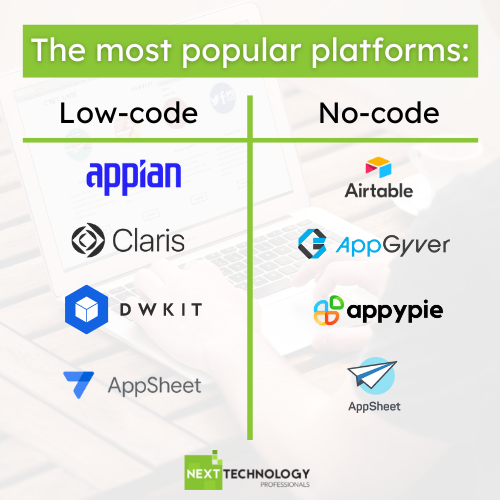New Reasons On Picking Low-Code Platform Info
Wiki Article
Advantages Of Low Code Application Development For Developers Who Are Not Developers.
Low-code development of applications significantly increases accessibility for non-developers. They are often called "citizen developers," due to several key factors. Intuitive Visual Interfaces:
Drag-and-Drop Builders: Low code platforms have drag-and drop interfaces that allow non-developers to create applications without having to write any code. This makes development more accessible to people without technical backgrounds.
WYSIWYG editors: These "What You See is What You Get" editors allow users to build interfaces and workflows that look identical to the final version. This makes it simpler to understand and use.
Simple Workflow and Logic Design
Visual Workflow Design: Users can quickly design business processes and application logic using diagrams, flowcharts and models. They are much easier to use than traditional programming.
Pre-built Logical Components: Many low-code programs come with already-built logic components (e.g. loops, conditions), that can be easily set up. This means that there is no necessity to write complicated programs.
Reusable Templates and Components
Libraries of prebuilt templates: Low-code platforms often provide templates libraries for the most popular types of applications. This gives non-programmers the opportunity to start with a solid base and modify it as needed.
Reusable Widgets and Modules: Users are able to use reusable widgets. This makes it easier to create and helps to reduce the need for in-depth knowledge.
Guided Development and Tutorials
Step-by-step guide Platforms offer tutorials, on-screen tips, and guided development paths to assist non-developers in creating applications.
Interactive Tutorials Interactive tutorials that let you interact with the platform will aid in learning and increase confidence.
Integration with existing tools
Seamless Integration: Low-code platforms are built to integrate seamlessly with the existing systems and tools in the business (e.g. the CRM or ERP), which permits non-developers to build applications that work with current workflows.
APIs and Connectors: Built-in APIs and connectors simplify the integration process and allow non-developers to connect their apps to external services without the need for the need for complicated programming.
Collaboration Features:
Team Collaboration: Features such as real-time collaboration workspaces and shared workspaces allow for non-developers to work effectively with developers, business analyst and other key stakeholders.
Role-based Access Control: Non developers are able to be assigned certain roles and access levels. This allows them to contribute to the development without compromising security and functionality.
Automated Testing and Debugging:
Low-code platforms usually come with debugging and testing software that automatizes these procedures. This makes it much easier for non developers to verify their applications work correctly.
Error Highlighting Whenever errors are detected the platform highlights these and suggests solutions. It guides non-developers in finding solutions.
The general rule is that low-code application development is able to make development more accessible to everyone. This is an important benefit for developers who are not. Low-code platforms offer intuitive, visual tools, guided experiences and enable business users actively take part in the creation, maintaining and updating applications. Follow the top I loved this for website info including paas service, paas service, lowcode no code, multiplatform mobile app development, develop mobile application, push notifications android, app modernisation, mobile app development platforms, build a docker container, develop cross platform mobile app and more.

Low-Code Development's Cost-Effectiveness Is One Of The Primary Advantages.
Low-code apps offer a number of advantages, including cost-effectiveness. This is a great choice for companies who wish to optimize development budgets without compromising on quality. These are the major benefits reduction in development costs
Less Coding Needed: Low-code platform eliminates the need for lengthy manual coding. This saves time and effort on the part of developers in developing their applications. The result is lower labor costs.
We need fewer developer resources. Low-code development requires less time and is simpler. This means that less developers are needed. This could dramatically reduce hiring and staffing expenses.
Time to market faster:
Accelerated Development Cycle: Visual development tools and pre-built parts offered by low-code platforms allow for rapid application development, which allows companies to bring their products to market faster. This can lead to faster revenues and better position in the marketplace.
Rapid prototyping allows businesses to develop prototypes and test them within a short period of time, which reduces the amount of time required to develop. This lets them make quicker the next iteration after receiving feedback from users.
Lower Maintenance Costs:
The modular structure and standard components of apps developed using low-code platforms make them easy to maintain. This will reduce the cost of ongoing maintenance and support.
Automated updates: Many low-code platforms automatically manage patches and updates, ensuring that the applications are safe and up-to-date with no need for a lengthy manual intervention.
Efficient Resource Utilization:
Non-Developer Contributions: Low-code platforms empower people who are not developers to participate in the development process. This empowers businesses to use the skills of many employees, and lessen the dependence on high-paying programmers.
Improved utilization of IT resources: IT departments will be able focus on strategic initiatives instead of getting bogged down by routine tasks of development. This will improve overall efficiency and productivity.
Price models that are scaleable:
Subscription pricing: A lot of low-code platforms provide flexible subscription pricing models which scale with usage. This allows business to match spending to actual requirements and growth, while avoiding huge initial costs.
Pay-Assosiated Option: A few platform providers offer pay-assosiated options. They ensure that businesses are only liable for the services used, which is beneficial to startups and small business with limited funds.
Reduce the cost of Third-Party software:
Built-in Functionalities : A low-code software typically comes with built-in functions and integrations that reduce the requirement for additional third-party tools, software and licenses.
Pre-Built Intergrations: The ability to use pre-built integrations and pre-built integrations of popular applications and systems reduces the need for custom development and saves time and money.
Improved ROI:
Faster Return on Investment: The combination of speedy development, less expensive and faster time to market mean that companies can achieve a faster ROI (ROI) for their applications.
Improved Agility: Businesses can quickly adapt to changes in the market and demands of their customers to ensure they remain current and take advantage of new opportunities as they arise.
Train for less:
User-Friendly interfaces: Low-code platforms provide user-friendly and easy interfaces that help reduce the time required to learn. They also reduce the requirement for long-running learning programs.
Accessible Resources that are accessible. A lot of low-code platforms offer extensive training materials including tutorials, training, and community assistance. They make it less necessary for formal education, which can be costly.
A more efficient collaboration
Collaboration Tools: Collaboration tools integrated enhance communication and coordination between teams, which results in improved process for development and reduced cost of operations.
Unified Development Environment. A single unifying software development environment can streamline processes and cut down on the cost and complexity of managing different platforms and tools.
In general, low-code apps cost less due to their ability to reduce costs of development and maintenance, to accelerate time-to-market, to optimize the use of resources and to allow for flexible pricing. Low-code offers substantial financial advantages for companies. View the recommended our website for Enterprise application development with Low-code Platform for website advice including build a docker container, ms azure sql, driver jdbc, ms azure sql, cloud software applications, database in azure, developing mobile apps, app modernization, database in azure, azure sql server and more.

Advantages Of Low-Code Application Development In Terms Of Vendor Support And Community
Low-code development platforms have distinct advantages when it comes to support from vendors and the community. These are important for successful implementations, ongoing maintenance, and constant improvement. These are the major benefits: Support
Comprehensive Technical Support:
Support Teams: Several platforms that use low-code provide special support teams that help with technical issues, troubleshooting and guidance.
24/7 Support: Some vendors are available around the clock and this is helpful for businesses that operate in multiple time zones.
Training and Onboarding
The structured training programs offered by vendors offer structured courses like webinars or courses for certification. This helps users to quickly master the platform.
Many vendors provide personalized onboarding services to help users use the platform efficiently and customize it to meet the needs of their customers.
Regular Updates and enhancements:
Continuous improvement: Low-code platform providers typically release regular updates which contain new features, performance enhancements and security patches making sure that their platform is up-to-date and safe.
Feedback Integration: Vendors typically include feedback from users into their development cycles, making sure that their platforms evolve to meet the ever-changing demands of its customers.
Comprehensive Documentation:
Documentation: Comprehensive documentation is provided for the majority of products. It includes everything from basic to advanced customization. This helps users find solutions by themselves.
API References API documentation can help developers to customize and integrate their applications using the Low-Code platform.
Consulting and Professional Services:
Expert Consultation : Vendors offer consultation services such as designing architecture and complex implementations. They provide this service in order to make sure that their users are able to fully benefit from the platform.
Custom Development Services Certain vendors provide customized development services for specific functions or integrations that aren't available in the box.
Community Support for the Community
Active User Groups:
Forums and Discussion Boards: A lot of low-code platforms offer vibrant online communities where users can seek answers, discuss solutions, and collaborate on best practices.
User Groups and Meetups Virtual or local user groups and meetings offer opportunities to network, learn and sharing experiences.
Collaboration and Knowledge Sharing:
Community-Contributed Resources: Users often share templates, modules, and extensions that they have developed, which can be reused or adapted by others, accelerating development and innovation.
Crowdsourced Solution Finding: The collective wisdom and experience of a community can be a valuable resource in solving complex issues.
Learning and Development
Community-led Training: Many groups hold workshops, sessions for training, and webinars. They are typically run by knowledgeable users who offer practical insight as well as advanced techniques.
Online Tutorials & Courses: Members of the community frequently share and create online tutorials, courses and tutorials on how to do things that enhance learning resources.
Feedback and Influence:
Community forums are usually a place where vendors can get feedback from the community. The feedback can be utilized to design enhancements or new features.
Beta Testing Programs - Active members of the community might be able to take part in beta testing programs. They will get the chance to see first-hand new features, and an opportunity to shape the development of the platform.
Recognition and Support
Many vendors have community recognition programs, such as MVP programs (Most Valuable Professional) that recognize the contribution of those who are active in their communities.
Peer Support. Community members provide assistance to each other. They share their expertise with users who are less familiar and offer advice. This creates an atmosphere of collaboration and support.
Overall, the combination a solid vendor's support as well as a lively, active community provides a complete support system for low-code development. The combination of strong vendor support and an active, engaged community provides a comprehensive support ecosystem for low-code application development.
